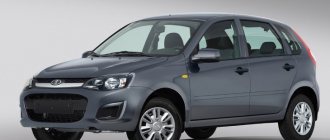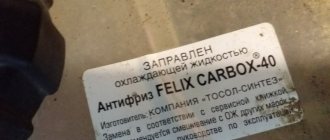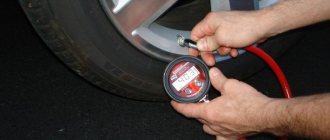Repair manual for Lada Kalina - Lada Kalina VAZ 1117, 1118, 1119 with 1.4 and 1.6 l engines
Repair manual for Lada Kalina cars of VAZ 1117, 1118, 1119 modifications - intended for auto repair shops and car owners who carry out repairs independently, with their own hands.
The manual describes in detail the repair work, replacement of components, assemblies and individual parts. The instructions are supplied with color photographs, comments and tips. Main parameters of the models
| Options | Car and its modifications | ||||
| VA3.11173. VA3.11174; VA3.11176 | VAZ.11183. VA3.11184. VA3.11186 | VAZ-11193. VAZ-11194. VA3.11196 | LADA KALINA Sport 1.4 | LADA KALINA Sport 1.6 | |
| Body type | 5-door station wagon | 4-door sedan | 5-door hatchback | ||
| Layout diagram | with transverse engine and front wheel drive | ||||
| Number of places, people | 5 | ||||
| Number of seats with rear seats fully folded, persons. | 2 | ||||
| Curb weight, kg | 1110 | 1080 | 1110 | ||
| Permitted (total) maximum weight (RMM), kg | 1585 | 1555 | 1535 | ||
| Ground clearance with RMM, not less, mm | 160 | 140 | |||
| Gross weight of towed trailer*, kg: | |||||
| - not equipped with brakes | 450 | operation with a trailer is not intended | |||
| - equipped with brakes | 900 | ||||
* in this case, the vertical load on the ball of the towing coupling device in a static state should be no more than 50 kg.
About the release of LADA Kalina (2) of the second generation
Oleg Grunenkov, director of the LADA Kalina project, AvtoVAZ OJSC
— LADA Kalina has been produced since 2005 and since that time the style of this car has not undergone any changes, although over the past year and a half we have introduced many additional options - headrests, a navigation system, parking sensors, a rain sensor, automatic headlights.
Well, now we present a new generation of Kalina, where the interior and exterior have been changed first of all. The development of the style of this car is the product of VAZ engineers and stylists, except for the front bumper trim, this style solution belongs to Steve Martin. The interior will be made in two different colors - dark color and traditional basalt, which is known from the currently produced LADA Granta car, and a new color developed specifically for LADA Kalina 2 - the color “titanium”, cooler, more austere. The salon has additional finishing; here you can see additional decorative inserts that make the interior more interesting and attractive. It is possible to equip the car with an automatic transmission or a new generation manual transmission with a cable type, but most likely this modern car will be in greater demand with an automatic transmission. Its engine capacity is 1.6 liters, ABS is provided, and there are four airbags - not only front airbags for the driver and passenger, but also airbags built into the backrests of the front seats. The car will meet Euro 4 requirements. The price niche will remain the same and will be between the LADA Granta and LADA Priora.
Today we present two new models of LADA Kalina 2 - a hatchback and a station wagon, these are the best-selling cars in Russia and we hope that they will remain just as popular in the future. Over time, we will make our car more modern, understandable, more convenient, more competitive. This car has a new, more modern style with a more expressive exterior. The shape of the front part of the car has been changed, which has become more functional, the headlight unit has a built-in running light, which has proven itself well on LADA Granta cars, this allows you not to turn on the headlights, which you can forget about, and the lights turn on automatically when you turn the ignition key. The interior of this car is also new and the color concept is shown here. The changes affected not only the interior body, changes also appeared in the engine, a new engine will be used here, which is borrowed from the LADA Grant, with improved fuel consumption and acceleration dynamics. The car's chassis will also undergo some changes, which are being finalized together with Renault. The car will have three trim levels - standard, normal and luxury. It is worth noting that the face stamps for Kalina were ordered from Japan, thereby guaranteeing the good quality of the body produced from them. Interior fittings are manufactured in Korea, ensuring good quality, fit and functionality of these parts. A German-Japanese company is responsible for the safety system in this car, which produces not only the steering wheel, but also all the airbags and seat belts. Many electromechanical system components in this car are becoming modern and are produced at modern factories in Russia or abroad. Taking into account the great interest from consumers, we are trying to make the car more interesting, more economical and dynamic.
Miscellaneous KALINA at the 1999 exhibition Electric car based on Lada Kalina Don't let the lock freeze Cooling system diagnostic kit
We expel air from the cooling system
The cooling system can become airy for various reasons, and first of all, the heater in the cabin stops blowing warm air, the temperature rises, and the antifreeze boils. If you squeeze the upper and lower radiator hoses, you feel that they are empty, there is no coolant in them. Often, “airing” occurs after replacing the heater radiator, and it is sometimes very difficult to remove air from the system. Alternatively, you can install an additional tee on the lower heater pipe under the hood, and lead the new hose into the expansion tank from above; a plug should be placed in the lower pipe from the tank to the lower radiator pipe.
Primary and secondary shafts
The gearbox has a two-shaft design. Each gear, except reverse, has synchronizers. The mechanism housing is composite and consists of a clutch housing, gearbox housing, and rear cover. Crankcase parts are made by casting from light aluminum alloys. Instead of gaskets between the housing elements, the manufacturer uses a sealant gasket. A magnet is installed in the holes of the oil filler plug, which is designed to trap debris.
A block of drive gears is installed on the primary shaft of the mechanism, which are constantly engaged with the driven gears of the forward gears. The secondary shaft is made hollow. Due to the hollow structure, oil enters the operating area of the driven gears. A removable main gear gear is installed on the secondary shaft - the drive gear. Driven gears and synchronizers are also mounted on the secondary shaft.
The shafts rotate on roller and ball bearings. The former are installed at the front, and the latter at the rear. Bearings are securely fixed on each shaft. Radial clearances for the front bearings are no more than 0.07 mm, and for the rear ones - 0.04 mm. For lubrication, an oil intake is used, which supplies oil to the secondary shaft.
The driven gear in the Kalina gearbox is mounted on the flange of the two-satellite differential box. The gearbox housing has a breather - it is located on top.
Oil
With the introduction of the new box, the amount of oil also changed. Thus, for the VAZ-2181 gearbox, the oil volume decreased by 30%. The requirements for oil have also changed - AvtoVAZ switched from mineral to synthetic gear oils. This applies to both old gearbox models and new ones. The manufacturer pours oil into the gearbox and writes in the instructions that it will last for 5 years or for the entire life of the gearbox. But in reality it needs to be changed.
The oil life of the Kalina gearbox is approximately 30 thousand km. You can choose any of the domestic transmission products as gearbox oil. Thus, domestic car enthusiasts speak well of the products of Lukoil and Rosneft. You can also purchase imported oils - for example from Zic. The box will say “thank you” for this.
Recommendations for the use of transmission oils for Kalina
Adding oil or replacing it in the Kalina gearbox will require an answer to the question of which substance to choose. It is better to build on the manufacturer's recommendations. The machine's operating manual provides a list of different oils. They are classified by:
- brand;
- viscosity grade (SAE);
- API group;
- to the manufacturer.
It is important which substance ensures stable operation of the gearbox in the widest temperature ranges. This is oil with viscosity marking 75W-90
It guarantees lubrication of components at temperatures from -40° to +45°.
Which gear oil has more universal properties? This can be considered a substance whose viscosity is designated 80W-85. If Kalina’s gearbox is filled with this oil, then normal operation of the units is maintained in climatic conditions from -26° to +35°.
Regardless of what oil is planned for use in the Kalina box, it is strongly recommended not to use various additives or other means. The use of high-performance gear oils does not require additional additives. Moreover, in some cases, the use of additional additives can lead to damage to the gearbox or other transmission units.
Basic problems and quick fixes
Lada Kalina is not difficult to maintain when dealing with liquids. So, you can change the oil yourself. To do this, you need a key for 17. If the station wagon engine capacity is 1.6 or 1.4, you need a little more than 3 liters of new fluid. We unscrew the filler cap on top, and under the body - a special plug-plug using a key. The waste solution will flow through this hole, so place a bucket in advance. The old oil filter is dismantled and a new one is installed; when the used fluid has been drained, you can add oil, checking the level with a dipstick.
Simple repairs are also carried out independently if the Lada Kalina does not meet the following parameters:
- creaking in the cabin and when driving - door lubrication and engine diagnostics;
- suspension is too stiff - replace or improve this part;
- electronics are not satisfactory, problems with the thermostat - replacement of faulty equipment;
- problems with reverse gear - diagnostics of brake and steering systems.
Many motorists admit that problems with this vehicle arise only after 100 thousand kilometers have been traveled. Do not forget that it is better to carry out routine diagnostics every year to exclude serious problems.
https://youtube.com/watch?v=a_VHBx2y5ok
Features of synchronizers
So, the gear part of the Kalina gearbox was not touched, and there are no changes here. But it is not so. For first and second gears, multi-cone synchronizers had to be installed. This was done first of all for the sake of overall reliability - the second gear is the most loaded. Due to the multi-cone synchronizer, the transmission life will be longer. In addition, such synchronizers were also used to make the effort to engage the gear minimal. Since the gearbox is also installed on other car models, including those with more powerful engines, the diameter of the clutch has been increased - now the mechanism has a diameter of 215 mm. The powerful clutch led to the production of another crankcase - the previous one from KPP-2108 could not accommodate such a large clutch mechanism. The maximum that could fit there was 200 mm. Because of the new crankcase, engineers had to move the starter to another location.
The first gearbox samples were equipped with a three-cone synchronizer, but it was quickly abandoned in favor of a two-cone synchronizer - the latter is cheaper and easily “digests” the required torque.
Design Features
The steering system of the Lada Kalina includes an electric power steering and a steering column that is adjustable in height and tilt. The steering mechanism is a steering rack with a variable transmission ratio. The rack engages with the engine crankcase through a gear having helical teeth, the pitch of which varies along the length of the rack. The figure shows the design of the Kalina steering rack.
The steering rack on Kalina is pressed against the gear by a spring. Friction is reduced by a plastic insert. The spring pressure is changed with an adjusting nut (the factory-set gap between the rack and the shaft is 0.1 mm). The second end of the rail rests against a plastic sleeve. Adjusting the gap helps eliminate knocking noises.
The steering system shaft is installed in bearings (one in the column bracket, the other in the electric booster housing). The column bracket is attached to the pedal bracket (front) and to the body bracket. The column bracket with the pipe is connected in the form of a hinge of two plates, which allows you to change the position of the steering wheel, and the range of movement is limited by the slots in the plates.
To fix the position of the pipe, there is a lever connected to the adjusting sleeve. It is screwed into a coupling bolt located in the slots of the plates. When you turn the lever, the bushing rotates, loosening the fixation of the plate, which allows you to change the position of the steering wheel. Springs between the plates and the bracket pull the pipe up when the fastening is loosened.
The steering system of the Lada Kalina has two tie rods and swing arms. The rod consists of external and internal tips and an adjusting threaded sleeve, which, when rotated, changes the length of the rod. The required adjustment of the rods is fixed with bolts. The rod is connected to the swing arm using an external tip that has a ball-type joint.
Kalina's electric power steering reduces the force applied to the steering wheel. It is assembled on the basis of an electric motor with a gearbox located under the steering system casing. The amplifier is controlled by an electronic unit that receives signals from sensors of vehicle speed, shaft rotation and steering torque.
The principle of operation of the amplifier is based on the fact that when the car is stationary, the torque on the steering shaft is the greatest, and when moving, it decreases with increasing speed. There is a power steering indicator on the dashboard.
https://youtube.com/watch?v=13qasRZk8gA










